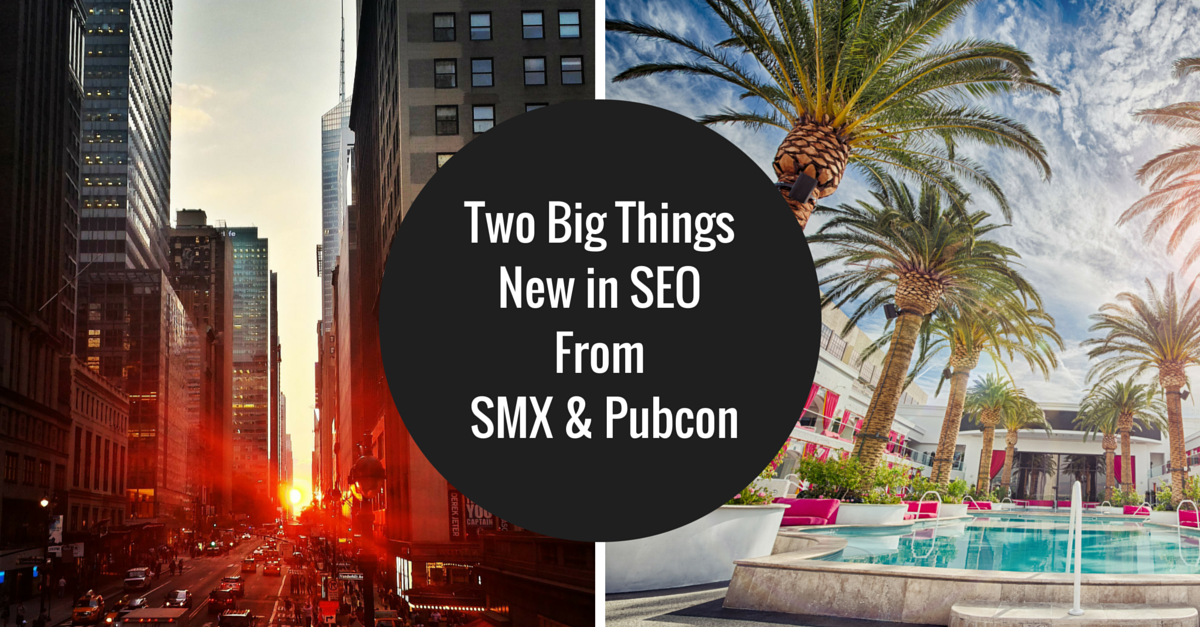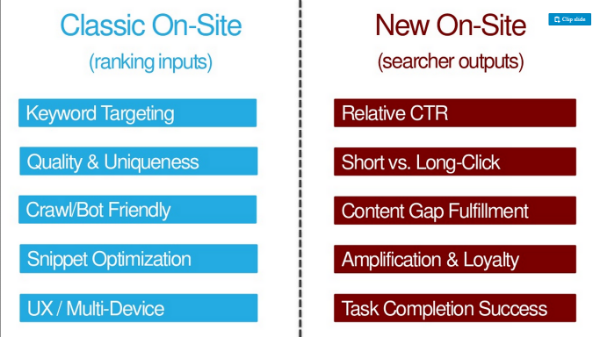2 Big Things Changing SEO Forever — What’s New in SEO from SMX & Pubcon
Digital marketers and SEO industry insiders demand outstanding content for their limited blog-reading bandwidth. So, for SEOs who want to get straight to the heart of the latest game-changers, we offer our humble opinion that during the SMX East and Pubcon Las Vegas conferences of the last month, there were two big comets that hurtled from the sky, signaling changes to the SEO landscape forever:
- Machine learning algorithms ranking content based on searcher behavior feedback
- Predictive search serving searchers content before they ask
Here’s your front row seat to what’s new in SEO, straight from SMX East and Pubcon Las Vegas.
How SEOs Can Optimize for an Algorithm That Is Learning
This week, Google confirmed artificial intelligence system RankBrain as the third most important signal in the ranking algorithm — an assurance that machine learning is at play in live Google results.
What is machine learning? Machine learning is where a computer teaches itself. Rather than following defined programming or learning through human intervention, the computer is programmed to learn by collecting and interpreting data.
Important to NoteAt Bruce Clay, Inc., we do not think Google is ready to surrender the fate of their entire algorithm to a black box. Machine learning is not easily undone or fixed from looking at the results. As such, we believe that the algorithm will never be wholly unleashed to machine learning capabilities. In order to maintain a clear view of the algorithm, Google engineers will control the parts of the algorithm where machine learning is in play. Search Engine Land has used the analogy of what’s happening under the hood of your car, with RankBrain being one component of a complex engine. Clarifications by Googler Gary Illyes and the Bloomberg author who broke the story, Jack Clark, add important context. |
Rand Fishkin, founder of digital marketing software house Moz, painted a picture of the future of search engine optimization while on stage at Pubcon this month. With machine learning in play, the computer program that ranks results will use searcher feedback as a ranking signal. He advised SEOs to optimize for searchers’ interactions with web pages and results.
Up until now, most of us have been optimizing for traditional elements of SEO — keyword targeting, quality, uniqueness, and snippet optimization. The algorithm now powered by machine learning theoretically allows Google to boost sites in SERPs using signals that aren’t on the page and the web but rather are coming from searchers as they interact with results. High relative click-through rate, signs of task completion, and long click vs. short click are among the signals Fishkin refers to as “searcher outputs.” An example of the latter (long click vs. short click): if a searcher clicks back to a results page quickly, that signals a poor result, and if this happens enough times, the algorithm will stop including this result as a query match.
What Optimizers Can Do: Searcher Output Signals
In Fishkin’s keynote presentation at Pubcon, he said that SEOs need to start optimizing for a new set of factors. So what are these new factors? “Searcher outputs,” the new elements of SEO include:
- Long to short click ratio
- Relative CTR vs. other results
- Rate of searchers conducting additional related searches
- Sharing/amplification rate vs. other results
- Metrics of user engagement across the domain
- Metrics of user engagement on the page (How? By using Chrome and Android)
For searcher outputs defined, and tips on how to optimize for them, read our coverage of “SEO in a Two Algorithm World” from Pubcon.
Predicting the Impact of Predictive Search
Predictive search (PS) technology is evolving rapidly. Are you getting notifications on your smartphone that the drive home will take 20 minutes in the currently heavy traffic? That’s predictive search in action — relevant notifications before you search. Google Now and Cortana are the virtual assistant applications at the forefront of predictive search.
What is predictive search? Predictive search is where an Internet connected device gives a user information relevant to his or her current situation and interests, often before the user asks for it. A user’s pattern of personal behaviors, the place, time, rate of movement, and of course, a user asking for information, are the factors that feed predictive search.
Cindy Krum’s presentation at SMX East, “Google Now, Microsoft Cortana, and The Predictive Search World,” is the best place to start for background on the signals being used to predict searches, where we’re seeing predictive search in our daily lives, and how predictive search is going to change SEO.
Note that predictive search is closely tied to Internet connected devices beyond the phone and computer, like wearables. As more Internet connected devices without keyboards come to market, voice powered search and served-before-you-asked information becomes necessary.
Predictive Search with Google Now
Of course, you’re likely familiar with predictive search if you’re a Google Now or Cortana user. Google Now, Google’s predictive search app, uses a “card” format to show users information they might find useful before they search for it.
Google Now collects a signed-in users online history across devices (phone, tablet, computers, TV, smart watch). It accounts for a user’s current conditions, including location, date, time and even velocity (are you on the way to work?). If it senses from your GPS location that you’re staying out of town, Google Now will provide you with the local weather, nearby attractions, and traffic information.
Your data from every Google app (including Gmail, Google Calendar, Google Maps, Google Play, Google Plus, Google Hangouts, YouTube, Google News) is used to aggregate a complete view of your interests so Google Now can serve up: meeting notifications, reminders, news stories you want to read, upcoming travel notifications, weather, traffic and alternate routes, TV shows, and nearby events. The list is growing every day.
What Optimizers Can Do: Voice Search SEO, Speed & App Indexing
During her presentation, Krum offered a possible avenue of exploration for getting your business into a users’ Google Now results: email markup for Google Now.
In his keynote message at Pubcon Las Vegas, Google’s Gary Illyes, explained that Google Now was created in part to satisfy the “needy,” and “impatient,” expectations of millennials. He provided tips on how to provide content for this generation that will make them “feel special” and “make life easier for them.” Read the liveblog of Illyes’ keynote for dos and don’ts of creating content that builds loyalty with millennials.
Along with Google Now, Illyes talked about other Google products that reveal where search is today and where it’s headed.
Illyes talked about voice search and how it interprets a string of questions in relation to the previous questions (Where is the Eiffel Tower? How tall is it?). For SEOs, voice search optimization is a technical and emerging practice that includes direct answer optimization and developing deep content expertise.
Illyes explained that search is now location-aware. He gives an example of this: you can stand in front of a restaurant and find out the hours by asking your phone “What are the opening times?” Keep in mind, you don’t have to tell your phone which restaurant you’re talking about because it will know by your location. Ensure that Google has clear and positive signals about your brick-and-mortar business location with proactive local SEO.
Illyes also pointed the audience to Accelerated Mobile Pages (AMP). The Accelerated Mobile Pages Project is a brand new, open source framework for building high performance, lightweight websites that work seamlessly across mobile devices. AMP is intended to deliver a faster, user-friendly experience for the mobile web. Investigate whether AMP standards should be in your next development cycle.
Illyes and Krum both talked about app indexing, and how Google is working to seamlessly integrate and open app results. For a starting place on mobile app indexing and deep linking see our SMX East report on “Why App Deep Linking Is the Next Big Thing.”
The New SEO
The SEO industry has always had a front row seat to the technological evolution. We’re at the forefront of machine learning algorithm factors and Internet connected devices serving you content before you ask for it. Ready to adapt?

9 Replies to “2 Big Things Changing SEO Forever — What’s New in SEO from SMX & Pubcon”
Very nicely written. SEOs need to understand the algoritham first if they wanna stay ahead in this rat race for longer period of time.
High relative click-through rate, signs of task completion, and long click vs. short click are among the signals Fishkin refers to as “searcher outputs.”
in other words User signals , proper engagement. Real users , real traffic
I’ve seen little to no patterns in Local Search to follow as we many companies still playing on the dark side seem to rank well even with newer sites/domains so I welcome this sort of Technology.
Great piece of information.
Needless to say, we should not be surprised to hear of this innovative method of ranking – in my opinion it’s actually very ingenious!
To me this is nothing more than an integral piece of the “Penguin” algorithm, and surely it will be successful in serving-up genuinely “relevant” results to end users.
Really stoked to see more big changes in the SERP’s ;-)
LEAVE A REPLY











